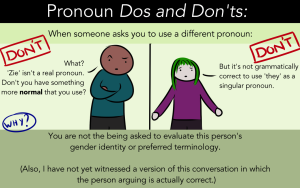Panel 1
(Person in cut-off shorts and T-shirt holding baby in a green onesie. Small child in a dress is standing behind their legs.)
Text: A 2016 study by Jennifer Glass shows a “parenting happiness gap” in many countries – meaning that people with kids report being less happy than those without. The gap is highest in the US.
Panel 2
(Person standing under a rainbow, reaching across a gap in the ground to help a grown person with a small child come to the other side)
Text: There are countries that don’t have this gap. These countries have policies like subsidized childcare and paid leave. Could the US be more like these countries? Could we, for instance, have a government-subsidized daycare program?
Panel 3
(Person sitting among daily clutter – water bottle, keys, coffee cup, kid’s toys – looking at phone while two kids try to also look at the phone)
Text: Well it turns out, we did, once.
Panel 4
(Left of text: WWII Support Our Troops poster. Right of text: Two congressmen signing a bill.)
Text: During WWII, as it became temporarily socially acceptable for white middle-class women to work outside the home, the need for childcare began to be acknowledged. In 1943, the the Lanham Act of 1940 began providing funding to childcare centers throughout the country.
Panel 5
(Homey looking daycare center with a line of parents and children heading towards it)
Text: These community-run centers received government funding and were open to families of all income levels and family structures, and provided up to six days of childcare for the equivalent of nine to ten dollars a day.
Panel 6
(Three mothers holding children, looking happy and peaceful)
Text: Mothers reported high levels of satisfaction with the quality of care, and researchers later showed long-term positive effects for children who had attended the centers.
Panel 7
(Women working in factory, soldier in foreground, woman to the right of soldier looks startled)
Soldier: Honey, I’m home!
Panel 8
(Daycare center from before, with “Closed” sign on it)
Text: But in 1946, as men returned home from war, the Lanham Act was rescinded. Few of the centers were able to continue providing care long-term once the government funding was removed.
Panel 9
(Woman in wedding and man in suit, standing in front of wedding officiant)
Woman: I do!
Man: I do!
Officiant: Ma’am, you’re fired!
Text: A “marriage ban” barred married women from higher paying careers, like teaching and clerical work. If a woman already working one of those jobs did get married, she was let go from her job.
Panel 10
(Paper chain figures of a family with mom, dad, and 2.5 kids. A pair of scissors next to pregnant mom)
Text: A picture-perfect nuclear family ideal reigned supreme, despite what may have been happening in reality.
Panel 11
(Women working at: computer job, back room of jewelry store, and bakery)
Text: Meanwhile –
Panel 12
Text: Mothers continue to work outside the home in large numbers. According to the Bureau of Labor Statistics, as of 2015, the labor force participation rate (people either working or seeking employment) for mothers of children under six was 64.2%.
For women with infants under a year old, the labor force participation rate was 58.1%. And this isn’t because men are no longer working outside the home – the labor participation rate for men with children under age eighteen was 92.7%.
Panel 13
(People working at: dog kennel, shipping center, school, wood shop, coffee shop, office job)
Text: Clearly, childcare is a necessity for many families.
Panel 14
(Families of various sizes standing on islands in the ocean)
Text: And yet, we have no national answer to the question of where young children will go, and who will take care of them, while their parent(s) work.
Panel 15
(Fish swim around below the islands)
Text: Each family is an island, left to figure it out on their own.
Panel 16
(Various families with kids)
Text: But why? If we know we can create a successful, nationwide government-funded system of childcare centers, why not do it?
Panel 17
(Paper chain nuclear family being held up by small children in sweatshirts with cartoon characters on them)
Text: Is a paper-thin vision of a nuclear family where dad works and mom stays home with the 2.5 kids continuing to guide policy? As a country, are we so invested in an imaginary status quo that we refuse to create policies that reflect reality?
Panel 18
(Mother with child on left, judge on right)
Text: Let us look at our history and learn that we can have national, affordable childcare – and ask what’s stopping us from having it now.






















